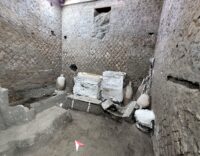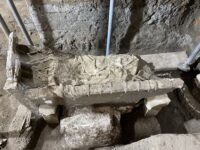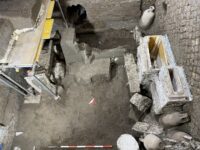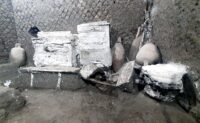 The furnishings of a room assigned to slaves in the grand suburban villa in Civita Giuliana, a half-mile northwest of the city walls of Pompeii, have been reconstructed in plaster. Using the plaster cast methods pioneered at Pompeii in the 19th century, the contents of the room were recreated from the cavities they left after they were encased in volcanic material and decayed while the ash hardened.
The furnishings of a room assigned to slaves in the grand suburban villa in Civita Giuliana, a half-mile northwest of the city walls of Pompeii, have been reconstructed in plaster. Using the plaster cast methods pioneered at Pompeii in the 19th century, the contents of the room were recreated from the cavities they left after they were encased in volcanic material and decayed while the ash hardened.
 The room, labelled Room A, is different from the one in the same villa, Room C, that was discovered in 2021. Room C was an active storage closet with three cots thrown in for rudimentary accommodation. Room A had two beds. One of them was a cot like the ones in Room C, with a net mounted on a wooden frame. It could be easily dismantled and moved.
The room, labelled Room A, is different from the one in the same villa, Room C, that was discovered in 2021. Room C was an active storage closet with three cots thrown in for rudimentary accommodation. Room A had two beds. One of them was a cot like the ones in Room C, with a net mounted on a wooden frame. It could be easily dismantled and moved.
 The other was a bed with a mattress and headboard, significantly more expensive and comfortable. The remains of the wooden headboard and sideboards that enclosed the bed like a snug are still in place. Some of the red paint decorating the wood panels has survived. The mattress has not, unfortunately, and it wasn’t Vesuvius that destroyed it. That’s the handiwork of looters when tunneling through the hardened ash looking for saleable treasure.
The other was a bed with a mattress and headboard, significantly more expensive and comfortable. The remains of the wooden headboard and sideboards that enclosed the bed like a snug are still in place. Some of the red paint decorating the wood panels has survived. The mattress has not, unfortunately, and it wasn’t Vesuvius that destroyed it. That’s the handiwork of looters when tunneling through the hardened ash looking for saleable treasure.
 A bench and two small cupboards in the room were also cast in plaster. Some of the contents — metal objects, a knife — were found in the cupboards. Amphorae in the corner and three chests on a high shelf on the walls of the room indicate this space was also used for practical storage purposes. Various tools, including an iron hoe, were kept in the room as well.
A bench and two small cupboards in the room were also cast in plaster. Some of the contents — metal objects, a knife — were found in the cupboards. Amphorae in the corner and three chests on a high shelf on the walls of the room indicate this space was also used for practical storage purposes. Various tools, including an iron hoe, were kept in the room as well.
Meanwhile, Room C continues to reveal new information. Micro-excavations of the amphorae found in the room have uncovered the skeletal remains of rodents: two mice in one amphora and a rat in a jug found under one of the cots. Apparently the rat jumped sought shelter in the vessel during the eruption.
“These details once again underline the conditions of precarity and poor hygiene in which the lower echelons of society lived during that time,” the culture ministry said in its statement.
There were no traces of grates, locks, or chains to restrain the room’s inhabitants.
“It seems that control was primarily exerted through the internal organisation of servitude, rather than physical barriers and restraints,” said Gabriel Zuchtriegel, the director of the Archaeological Park of Pompeii.
Human beings suffering at the hands of fellow mortals is a great misfortune. Slavery has been a sad and a shameful chapter in human history. The primitive practice needs to be done away with in these modern times.